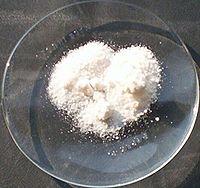
Photo from wikipedia
Abstract The relation between surface chemistry and (Opto)electrical properties of lead sulfide quantum dots (PbS QDs) is of importance for the development of cost-effective field-effect transistor (FETs) and quantum dot… Click to show full abstract
Abstract The relation between surface chemistry and (Opto)electrical properties of lead sulfide quantum dots (PbS QDs) is of importance for the development of cost-effective field-effect transistor (FETs) and quantum dot solar cells. Herein, simple chloride surface treatment has been demonstrated by adding tetramethylammonium chloride (TMACl) into a QD washing step. Absorption, photoluminescence (PL) and X-ray photoelectron spectroscopic studies revealed that Cl− ions bound strongly to PbS QDs surfaces resulting in enhanced PL of colloidal QDs. Furthermore, FET studies on PbS QD thin films fabricated by an identical solid-state ligand exchanging with 1,2-ethanedithiol (EDT) showed that TMACl treatment enhanced hole mobility by ten times and at the same time switched the EDT-treated QD thin film from p-type to ambipolar semiconductor with electron mobility of 2.8 × 10−2 cm2V−1s−1. The results demonstrated herein offer a simple treatment for the fabrication of multiple QD junctions with minor change in processing.
Journal Title: Chemical Physics
Year Published: 2020
Link to full text (if available)
Share on Social Media: Sign Up to like & get
recommendations!